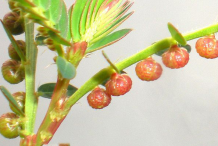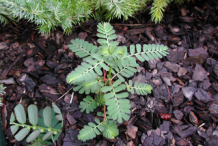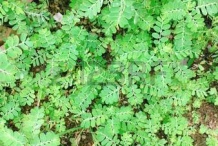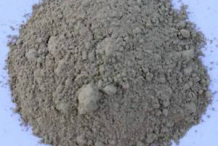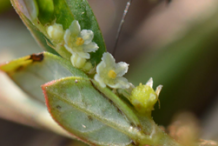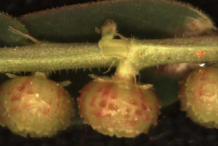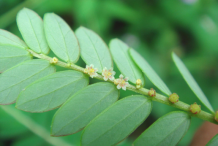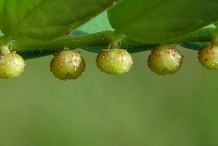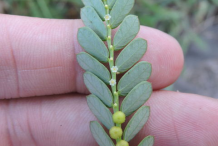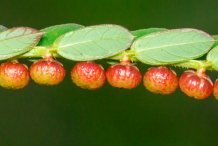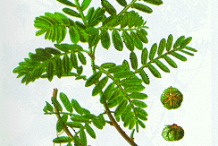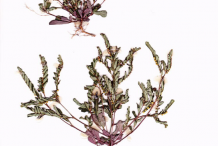| Chamber Bitter Quick Facts |
| Name: |
Chamber Bitter |
| Scientific Name: |
Phyllanthus urinaria |
| Origin |
Asia and has spread as a weed |
| Colors |
Green, red or greenish-red |
| Shapes |
Globular capsule about 0.12 in. (3 mm) in diameter |
| Taste |
Bitter, sweet |
| Health benefits |
Beneficial for acute and chronic Hepatitis B. Diabetes, dysentery, flu, tumors, headache, fever, Jaundice, Vaginitis, Conjuntivitis, bloating, Dysentery |
Chamber bitter scientifically known as Phyllanthus urinaria is a member of the Spurge family (Euphorbiaceae) and is native to Asia and has spread as a weed all the way through the tropics. It also occurs in tropical Africa and the Indian Ocean islands, but it is not common there. Other popular common names of the plant are gripe weed, little mimosa, Chanca piedra, shatter stone, meniran, stone breaker, quebra pedra, zhen chu cao, ye xia zhu, chamber bitter, kilanelli, leaf flower and komikansou. It is a warm-season broad leaf annual and typically appears around May or June when the soil temperatures have warmed to approximately 70 degree Fahrenheit. The genus name Phyllanthus is derived from Greek words which mean leaf (“phyll”) and flower (“anthus”). The specific epithet urinaria normally refers to plant’s use in traditional medicine to treat urinary diseases. It is commonly known as Chamberbitter or Stonebreaker, due to its use as an herbal medication for urinary tract stones.
Chamber bitter plant is casually similar to those of sensitive plant (Mimosa pudica), but in fact sensitive plant has compound leaves with elliptic leaflets. The plant normally spread by its seeds which are located on the bottom sides of the branch. Yet it is a widely distributed tropical weed. It is a weedy species in gardens, lawns and nurseries in tropical areas. It is considered as a pest of rice in Southeast Asia. Nowadays the plant is considered to be one of the best medicinal herbs particularly for the management and treatment of kidney stones.
Plant Description
Chamber bitter plant is an erect to prostrate, slender, glabrous annual or short-lived perennial herb that normally grows about 20-70 cm tall. The plant s found growing in dry fields, clearings, roadsides, waste places, gardens and along paths, but is also found in evergreen forest. The plants prefer moist, fertile soils, on cultivated fields, grasslands arable peat and also on roadsides as well as waste ground. It is a warm-season; annual, broadleaf weed that develops from warm soils throughout the early summer. The plant reproduces by means of seedlings which are found in the green, wart-looking fruit attached to the base of the branch. Chamber bitter usually grows upright and has a well-developed taproot. Stem is erect, more or less crimson red and usually exudes transparent latex when it is cut. Reddish branchlets are 5–13 cm long, flattened, often slightly winged and sparsely hairy.
Leaves
Leaves are arranged alternately along with erect, red stem. They are oblong or oblong-obovate, 7-18 mm long and 7.3 mm wide. It is rounded with a pointed apex and obliquely rounded at the base. The leaves are large at the top and small at petiole. Whenever touched, the leaves shrink automatically just as Mimosa Pudica (Touch-me-not). Leaves are bright to dark green above and gray-green to reddish tinged below.
Flower
Flowers are quite small and yellowish white. They are 5-merous, axillary and about 1 mm in diameter. Male and female flowers are found on the same plant. Male flowers are ovate or ovate-oblong with greenish sepals, yellowish-white with a green middle strip, erect anther cells, the slits vertical. Female flowers with sessile or very short pedicels 0.15-0.30 mm long, ultimately 0.55-0.68 mm, thickened all over with reddish sepals in the middle, ovary warty. Fruits are found along the underside of the stems.
Fruits
Fruits are green, red or greenish-red globular capsule about 0.12 in. (3 mm) in diameter usually warty, hanging and 6-seeded. The fruits are divided into three parts and their surface has raised scales. Seeds are 1 mm long transversely ribbed on the back, and sides.
Chemical constituents
The chemical composition and pharmacology of Phyllanthus urinaria have been subject to many investigations. The following chemical constituents have been found: lignans (e.g. phyllanthin, phyltetralin, hypophyllanthin, urinatetralin, dextrobuschernin, 5-demethyoxynirathin and urinaligran), ellagitannins (e.g. corilagin, geraniin, hippomanin A, phyllanthusin F and G, repandinin B and phyllanthusiin U), terpenoids (e.g. β-amyrin, lupeol acetate and β-sitosterol), flavonoids (quercetin, astragalin, quercitrin, rhamnocitrin, isoquercitrin, kaempferol, daucosterol, triacontanol and rutin), phenolic compounds (e.g. caffeic acid, ellagic acid, gallic acid, methylester dehydrochebulic acid, methyl brevifolincarboxylate, hexacosanoic acid, brevifolin, brevifolin carboxylic acid, pyrogallol, n-octadecane, methylgallate, trimethyl-3,4-dehydrochebulate, 1,3,4,6-tetra-O-galloyl-β-d-glucose) and waxes (montanoic acid methyl ester, triacontanol).
Traditional uses and benefits of Chamber bitter
- Frequent micturition and bladder diseases can be cured with the decoction of bark.
- Decoction is used against colic and stomachache by the mother of a newborn child in Surinam.
- Infusion of the plant is effective for kidney problems.
- Plant is used for liver problems in general such as acute and chronic Hepatitis B. Diabetes, dysentery, flu, tumors, headache, fever, Jaundice, Vaginitis, Conjunctivitis, Menstrual disorders and dyspepsia uncomfortable feeling in the upper middle part of the stomach.
- It is used against colic, and as an effective remedy to eliminate gall and kidney stones, urinary tract infection (UTI) and bladder inflammation.
- It is also used for blennorrhagia (gonorrhea).
- Paste prepared from Chamber Bitter, rock salt and water in copper utensils when applied around the eye is beneficial for eye disorders.
- Decoction obtained from boiling whole plant when taken about 1 tsp every day is beneficial for cough.
- Paste obtained from 10 g root with water when taken with 1 tsp rock sugar or honey is effective for Respiratory diseases.
- Mixture of 100 g leaves and 250 ml milk is beneficial for Ascites as well as urinary diseases.
- Consuming 10 ml Decoction obtained from heating 50 g whole plant along with 400 ml water is beneficial for Ascites.
- Decoction obtained from boiling 20 g leaves of Chamber Bitter along with 200 ml water is beneficial for bloating as well as Dysentery.
- Decoction obtained from boiling 50 g whole plant with 400 ml water when taken with fenugreek powder is effective in diarrhea.
- Paste prepared from 5 g root when taken with 250 ml milk in empty stomach is beneficial for jaundice.
- Powder prepared from whole plant along with 20 black pepper when taken 2-3 times a day is beneficial for diabetes.
- Mixture of 10 ml Chamber Bitter juice along with cumin and Jaggery is beneficial for urinary diseases.
- Paste prepared from immature leaves when applied over wounds is beneficial for wound healing.
- Paste prepared from leaves along with salt when applied over itch is beneficial for itchiness.
- Decoction obtained from leaves is beneficial for skin disorders.
- Paste prepared from leaves is beneficial for itch in your legs.
- Paste prepared from equal amounts of Chamber Bitter leaves along with black pepper and nutmeg is made into small medicinal pills. Such pills when taken 2 times a day is beneficial for malarial fever as well as other recurring fevers.
- Plant decoction is drunk and plant ash in water is applied as ear drops to treat earache in Nigeria.
- Bitter leaves are eaten to treat hiccup and cough.
- Decoction of young shoots or roots is taken to treat dysentery, malaria and typhoid fever.
- Decoction of the whole plant is taken to fight jaundice and gonorrhea and is topically applied as a poultice to treat skin problems such as ulcers, sores, swelling and itch.
- Plant decoction is drunk as a diuretic and purgative to treat diarrhea, painful urination, syphilis and liver problems, and also to treat fever in Madagascar, Reunion and Mauritius.
- Stem or leaf infusion is taken to treat bronchitis and asthma and is externally applied to treat parasitic skin diseases in Madagascar.
- Leaf infusion is taken to treat cough in Rodrigues.
- It is used as a diuretic and purgative to treat a wide variety of uro-genital disorders, diarrhea and diabetes, as a bitter tonic and to treat fever, including malaria throughout the world.
- Extracts are widely used against hepatitis B infections in Asia.
- Crushed plant parts or an infusion are applied to treat ulcers, sores and tumors.
- Crushed plant is used as fish poison in India.
- Leaf or stem bark decoction is taken as a diuretic to treat venereal diseases and pain caused by kidney stones.
- Sap of leafy twigs, or a twig decoction, is consumed to treat pain in the side.
- Paste of fresh crushed leaves and kaolin in water is drunk and applied to the body to treat convulsions, colic, constipation and urethral discharges.
https://www.youtube.com/watch?v=jATm3tupGc8
Effect
Phyllanthus urinaria is considered as a weed in several countries disturbing several crops like rice, potato, tobacco, groundnut, coconut, young cocoa, maize, cotton, various vegetables and fruit orchards. Certain form of economic loss in yield and quality is caused on crops where the weed is prevailing. To stop those losses, weeding operations need to be carried out, and these will suffer extra costs to farmers. In countries where credit and cash flow are a problem, weeding operations will have a negative economic impact on farmers. However, it may appear that the economic uses of and benefits from P. urinaria as a popular medicinal plant in many countries outweighs its adverse effects as a weed in agricultural and non-agricultural areas. The pharmacological and medicinal properties of the plant as an analgesic, a relaxant, retroviral, and retro bacterial agent have been exploited to cure hepatitis, kidney, urinary, bladder and other ailments. P. urinaria is an alternative host of pests and diseases that could have economic impacts.
References:
https://www.itis.gov/servlet/SingleRpt/SingleRpt?search_topic=TSN&search_value=28381#null
http://www.hear.org/pier/species/phyllanthus_urinaria.htm
https://plants.usda.gov/core/profile?symbol=phur
http://www.theplantlist.org/tpl1.1/record/kew-155097
https://davesgarden.com/guides/pf/go/71283/
https://en.wikipedia.org/wiki/Phyllanthus_urinaria
https://www.cabi.org/isc/datasheet/46061
Comments
comments



